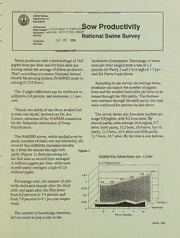
Sow productivity : national swine survey PDF
Preview Sow productivity : national swine survey
Historic, Archive Document Do not assume content reflects current scientific knowledge, policies, or practices. i : eT be United States Department of Agriculture primal end -oxssuewrocomcunmmOW Productivity Animal and Inspection NATIONAL AGRICULTURAL LIBRARY National Swine Survey Service DEC 22 1994 Veterinary Services Swine producers with a herd average of 10.8 incidences of mummies. Percentage of mum- piglets born per litter and 9.9 born alive are mies per litter ranged from a low of 1.2 scoring within the average of fellow producers. percent for Parity 2 and 5 to a high of 1.7 per- That’s according to a recent National Animal cent for Parity 6 and above. Health Monitoring System (NAHMS) study in- volving 21,712 litters. According to the survey, the average swine producer can expect the number of piglets The .9 piglet difference can be attributed to born and the number born alive per litter to in- stillbirths, 6.8 percent, and mummies, 1.3 per- crease through the fifth parity. This increase cent. may continue through the sixth parity, but data were combined for parities six and above. "Nearly two-thirds of the litters studied had at least one death,” pointed out Dr. Joe The survey shows that first-time mothers av- Connor, chairman of the NAHMS committee erage 9.9 piglets, with 9.2 born alive. By for the American Association of Swine second parity, sows average 10.4 piglets, 9.7 Practitioners. alive; third parity, 11.2 born, 10.4 alive; fourth parity, 11.3 born, 10.4 alive; and fifth parity, The NAHMS survey, which studied sows by 11.7 born, 10.7 alive. By the time a sow farrows parity (number of times sow has farrowed), dis- covered that stillbirths increased steadily by .1 from the second through sixth Figure 1. parity (Figure 1). Sows farrowing for Stillbirths/Mummies per Litter the first time or second time averaged .6 stillborn piglets per litter while sows # of Piglets/Litter in sixth parity averaged a high of 1.0 stillborn piglet. a Percentage-wise, the number of still- births increased sharply after the third litter and again after the fifth litter: from 6.2 percent to 7.4 percent and 0.5 from 7.8 percent to 9.1 percent respec- tively. SE Re CRA A> je Stillborn ,, a ionic: The number of farrowings, however, 1 2 3 4 5 6+ Parity Number did not seem to play a role in the March 1992 more than five times, the number born drops Figure 2. to 11.4, with 10.2 alive (see Figure 2). Number of Piglets per Litter by Parity ; # of Piglets/Litter "At first glance, the numbers might not seem significantly different," Connor inter- jects. "But when you pencil it out, averaging 10.7 piglets per litter versus 9.2, and talking eo MMMM [J # Born dollars and cents, it all adds up. # Born alive EES # Weaned "In gross dollars, we’re talking $150 per sow per farrowing. In weaned pigs, at a $25 price, this difference will pencil out to 1 2 3 4 § 6+ $37.50. Now take that times say 50 sows and Parity Number you're talking quite a few dollars." Although the number of piglets born per percent will die before weaning. Second-litter litter increases through the fifth parity, the females scored the lowest percentage of pre- number born alive does not increase at the weaning deaths, 13.7, while fifth-litter females same rate. (See Figure 2.) The percentage of had the highest, 17 percent. Preweaning piglets born alive declines slightly after the mortality by parity: 14.7 percent, first parity; second parity, and the percentage weaned also 13.7 percent, second parity; 15.5 percent, third falls after the second litter. parity; 15.4 percent, fourth parity; 17.0 per- cent, fifth parity; and 15.2 percent after the No, not all piglets born alive make it to fifth parity. weaning. NAHMS statistics show that 15 The National Swine Survey was a cooperative effort of swine health and management practices from 1,661 State agricultural departments; universities; and the farms. following USDA agencies: Extension Service (ES), National Agricultural Statistics Service (NASS), and Seven hundred and twelve (712) producers agreed to Animal and Plant Health Inspection Service (APHIS). continue providing data to State and federal Veterinary The study of swine health and productivity was con- Medical Officers (VMO’s). Each farm was visited a ducted from December 1989 through January 1991. The total of four times over a 90- to 120-day period. Data objectives were to provide information on the produc- collection instruments such as diary cards were imple- tion and health levels of the United States’ swine herd, mented to collect prospective data on the farrowing to and to suggest factors that may affect preweaning mor- weaning stage of swine production. The producers bidity and mortality. recorded observations of clinical signs associated with illness and death in sows, gilts, and preweaning piglets. A Statistical sample of producers from 18 States was selected to provide inferences about the nation’s hog National Animal Health Monitoring System population. The resulting estimates represent 95 per- USDA:APHIS:VS cent of the United States’ swine population. 555 South Howes, Suite 200 Fort Collins, Colorado 80521 The National Agricultural Statistics Service (NASS) (303) 490-7800 selected the sample and collected retrospective data on N94.0192
